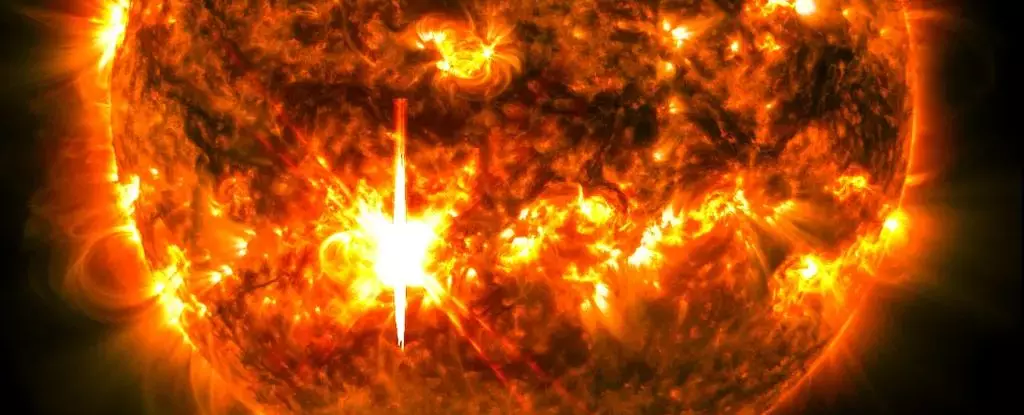As October dawns with its chilly embrace, our celestial neighbor, the Sun, has made headlines with an extraordinary display of energy and power. On October 1st, the Sun unleashed an X7.1 class solar flare—the second most powerful observed during the current solar cycle—accompanied by a significant coronal mass ejection (CME). This event, remarkable in both its scale and timing, sets the stage for a series of geomagnetic phenomena that could affect Earth and illuminate our nights with breathtaking auroras. The complexity of solar activity reveals much about the underlying mechanics of our star and its impact on space weather.
To fully appreciate the significance of an X-class flare, it’s crucial to understand the conditions that lead to such phenomena. Solar flares and CMEs often emerge from sunspots, regions that exhibit strong magnetic fields and are darker than their surroundings. They serve as sites for intense magnetic activity, where opposing magnetic fields can interact chaotically, creating conditions ripe for explosive releases of energy. When these heels of chaos align effectively, they unleash solar flares—bursts of radiation traveling at light speed—and CMEs, which release massive clouds of charged particles into space.
The flare in question originated from a sunspot complex identified as AR 3842, characterized by a Beta-Gamma-Delta magnetic configuration. This intricate arrangement of magnetic field lines makes such regions particularly volatile, increasing the likelihood of significant flare activity. As AR 3842 continues its transit across the solar disk, scientists keenly observe any further eruptions that could deliver additional surges of solar particles toward Earth.
Although the recent flare poses no immediate danger to life on Earth, its associated CME is expected to stir our planet’s magnetosphere, likely resulting in geomagnetic storms categorized from minor to strong between October 3 and October 5. The forecast from the National Oceanic and Atmospheric Administration (NOAA) and other meteorological agencies anticipate G3-level storms—usually associated with moderate disruptions to communications and power systems.
Geomagnetic storms have a unique relationship with the upper atmosphere, where solar particles collide with atmospheric gases, creating spectacular natural light displays known as auroras. Such events provide both a scientific interest and a visual feast. The Northern and Southern Lights transform dark skies into vivid tapestries of color, making geomagnetic storms a double-edged sword—harbingers of awe and caution.
Historically, the current solar cycle is characterized by several noteworthy solar flares. Though the X7.1 flare is exceptionally powerful, it is not the strongest of the cycle; that distinction belongs to an X8.7 flare noted earlier in May. The May event was particularly memorable as it produced some of the most vivid auroras documented, raising expectations for the forthcoming days.
Unlike a simple electric switch flipping on and off, solar activity is a more intricate procedural affair. The varied intensity of flares and their resultant geomagnetic storms is influenced by factors including the orientation of the magnetic fields and the sunspot’s trajectory relative to Earth. This scientific maze highlights the unpredictable nature of solar weather, making it an area of ongoing research and observation.
The forecasting of geomagnetic storms and auroral displays does not solely rely on advanced technology but also taps into the broader scientific community. Organizations like the NOAA’s Space Weather Prediction Center, along with international counterparts such as the British Met Office and the Australian Bureau of Meteorology, collaborate to provide timely updates and warnings. Their efforts bring scientists, educators, and the public closer together in a shared understanding of how space weather can manifest on Earth.
Community engagement also plays a significant role during such events. Enthusiasts and academics alike track solar activity, share photographs of auroras, and contribute to a growing body of knowledge regarding astrophysical phenomena. It creates a sense of unity, as people gather to witness the beauty the cosmos offers in reaction to solar events.
As we anticipate the nights ahead, there is an air of excitement surrounding the potential for stunning auroras, driven by the recent solar activity from AR 3842. In a world increasingly fascinated by science and its wonders, the events in space remind us of our cosmic connection and the vastness beyond our planet. Each solar flare brings a blend of caution and exhilaration—a reminder that our universe operates on a grand scale, governed by forces both familiar and mysterious. Thus, as we look to the heavens, let us remain vigilant and appreciative of the majesty and unpredictability of our Sun.


Leave a Reply